
How to make spaghetti sauce out of whole tomatoes
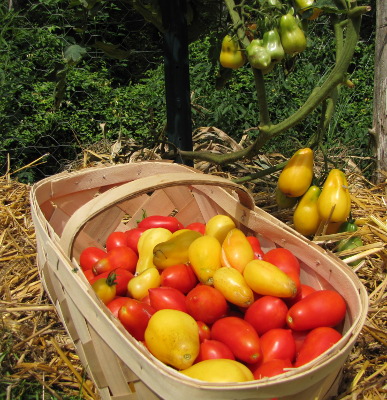 I
used to hate spaghetti night when I was a kid. My parents made
the sauce from scratch, and the result was both watery and chunky ---
pretty much par for the course with homemade tomato sauces. When
I was finally introduced to storebought spaghetti sauce, I fell in
love. Three years of trial and error later, I finally figured out
how to make a full-bodied tomato sauce with homegrown tomatoes that
tastes even better than the stuff in the jar and is just as good for
you as the kind my parents made.
I
used to hate spaghetti night when I was a kid. My parents made
the sauce from scratch, and the result was both watery and chunky ---
pretty much par for the course with homemade tomato sauces. When
I was finally introduced to storebought spaghetti sauce, I fell in
love. Three years of trial and error later, I finally figured out
how to make a full-bodied tomato sauce with homegrown tomatoes that
tastes even better than the stuff in the jar and is just as good for
you as the kind my parents made.
Start
with roma tomatoes.
There are two main types of tomatoes when it comes to cooking --- romas
and everything else. Roma tomatoes have less water and more flesh
than any other kind of tomato, and they also tend to have few enough
seeds that I make my sauces with skins and seeds in. It's okay to
include some extra slicers and tommy-toes as long as the romas
overpower their wateriness and seediness.
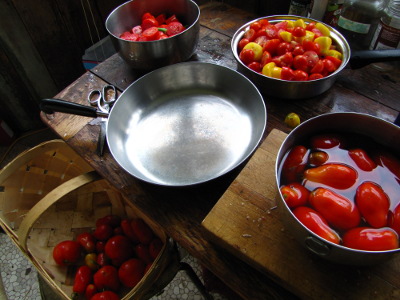 Get out your biggest skillet. The trick to making a
spaghetti sauce that turns out creamy and not watery is to let the
pectin in the tomatoes do its magic --- you're basically making
tomato jam. To that end, you're in a race against the naturally
occurring enzymes that start to break down the pectin in your tomato as
soon as the flesh is cut. The enzymes are activated by air and
then denatured (made inactive) by heat, so you need to keep your
tomatoes intact until the last minute, then heat the whole mass of
tomatoes up as fast as possible. Thus the skillet --- more
surface area on the burner means your sauce comes to a boil
faster. Plus, there's more surface area through which excess
water can cook off.
Get out your biggest skillet. The trick to making a
spaghetti sauce that turns out creamy and not watery is to let the
pectin in the tomatoes do its magic --- you're basically making
tomato jam. To that end, you're in a race against the naturally
occurring enzymes that start to break down the pectin in your tomato as
soon as the flesh is cut. The enzymes are activated by air and
then denatured (made inactive) by heat, so you need to keep your
tomatoes intact until the last minute, then heat the whole mass of
tomatoes up as fast as possible. Thus the skillet --- more
surface area on the burner means your sauce comes to a boil
faster. Plus, there's more surface area through which excess
water can cook off.
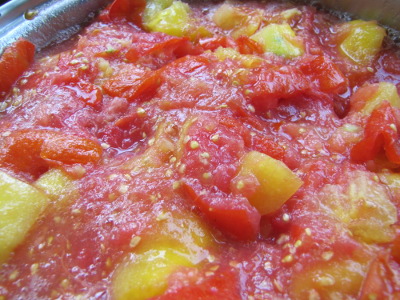 Prepare your tomatoes. Romas don't have any
core to speak of, so after a quick rinse, you can just lop off the very
top where the stem was attached. Quickly chop each roma into
three pieces and toss them in the skillet. (Note: I'm of the
"skins and seeds are good for you and taste fine" school of
thought. If you disagree, you'll want to remove both at this
stage.) Once you've cut all of the tomatoes into large chunks,
take big handfuls and squeeze them until there's enough liquid in the
pan that the tomatoes won't stick to the bottom and burn.
Prepare your tomatoes. Romas don't have any
core to speak of, so after a quick rinse, you can just lop off the very
top where the stem was attached. Quickly chop each roma into
three pieces and toss them in the skillet. (Note: I'm of the
"skins and seeds are good for you and taste fine" school of
thought. If you disagree, you'll want to remove both at this
stage.) Once you've cut all of the tomatoes into large chunks,
take big handfuls and squeeze them until there's enough liquid in the
pan that the tomatoes won't stick to the bottom and burn.
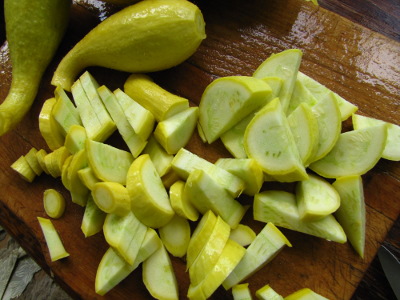 Add other ingredients. Put your skillet of
tomatoes on the stove on medium-high heat (stirring the contents
occasionally so nothing sticks) and add anything else you like in your
spaghetti sauce. One of my large skillets holds about a gallon of
tomatoes, and to this I generally add 1 onion (sliced), 3 cloves of
garlic (pressed), 3 or 4 dried bay leaves, and some salt and
pepper. At the very end, I'll also add a lot of fresh basil
leaves and will vainly try to fish the used bay leaves out. If
I'm going to add hamburger meat, I usually cook it up separately and
add the meat at the end. Squash, peppers, or other vegetables can
go in about thirty minutes before the sauce is done.
Add other ingredients. Put your skillet of
tomatoes on the stove on medium-high heat (stirring the contents
occasionally so nothing sticks) and add anything else you like in your
spaghetti sauce. One of my large skillets holds about a gallon of
tomatoes, and to this I generally add 1 onion (sliced), 3 cloves of
garlic (pressed), 3 or 4 dried bay leaves, and some salt and
pepper. At the very end, I'll also add a lot of fresh basil
leaves and will vainly try to fish the used bay leaves out. If
I'm going to add hamburger meat, I usually cook it up separately and
add the meat at the end. Squash, peppers, or other vegetables can
go in about thirty minutes before the sauce is done.
 Cook the sauce until it thickens. Delicious spaghetti
sauce has to be cooked long enough for the pectin to do its work.
I start the pan on medium-high until the contents are boiling hard,
then turn the heat down a bit at a time over the next hour or two until
the setting is on medium-low. During that time, the tomatoes will
cook down to about half their original volume. For quite a while,
you'll be stirring a pan of tomatoes and onions, but then, all of a
sudden, you can barely see individual components and the sauce tastes
and looks like sauce. Success!
Cook the sauce until it thickens. Delicious spaghetti
sauce has to be cooked long enough for the pectin to do its work.
I start the pan on medium-high until the contents are boiling hard,
then turn the heat down a bit at a time over the next hour or two until
the setting is on medium-low. During that time, the tomatoes will
cook down to about half their original volume. For quite a while,
you'll be stirring a pan of tomatoes and onions, but then, all of a
sudden, you can barely see individual components and the sauce tastes
and looks like sauce. Success!
Don't
worry if you scorch the bottom. I tend to forget to
stir nearly every batch at a critical stage and a bit of sauce sticks
to the bottom and burns. Whatever you do, don't
scrape that burnt bit back into the sauce and don't ignore it and keep
simmering. Instead, quickly pour off all of the good sauce into a
new skillet and set the scorched pan in the sink, filled with water, to
soak. As long as you don't stir the burnt sauce in or let the
good sauce sit on top of it long, you won't be able to taste the error
at all. (Maybe if you could, I'd be better about stirring and
wouldn't always let my spaghetti sauce burn?)
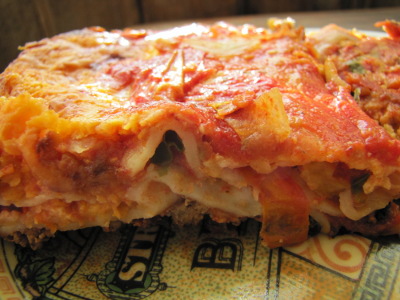 Lasagna is better for you than spaghetti. By now, I'm sure some
of you are wondering why I go to so much trouble to make spaghetti
sauce when we've deleted spaghetti from our diet and cut grains down to
a bare minimum. The same sauce can be used to make a high protein
and high vegetable lasagna that keeps my body healthy and my
spaghetti-loving tastebuds happy. To assemble a 9X13" pan of
lasagna, I use about a skillet and a half of spaghetti sauce, half this potsticker
dough recipe for the
noodles (which can be layered in uncooked), 1.5 pounds of hamburger
meat (cooked), quite a bit of cheddar, mozarella, and parmesan cheeses,
and any subset of cooked leafy greens, sliced summer squash, and sliced
mushrooms. Starting from tomatoes on the vine, it takes perhaps
three hours to make up a big pan of lasagna, but then we have quick
leftovers to heat up for lunch nearly all week!
Lasagna is better for you than spaghetti. By now, I'm sure some
of you are wondering why I go to so much trouble to make spaghetti
sauce when we've deleted spaghetti from our diet and cut grains down to
a bare minimum. The same sauce can be used to make a high protein
and high vegetable lasagna that keeps my body healthy and my
spaghetti-loving tastebuds happy. To assemble a 9X13" pan of
lasagna, I use about a skillet and a half of spaghetti sauce, half this potsticker
dough recipe for the
noodles (which can be layered in uncooked), 1.5 pounds of hamburger
meat (cooked), quite a bit of cheddar, mozarella, and parmesan cheeses,
and any subset of cooked leafy greens, sliced summer squash, and sliced
mushrooms. Starting from tomatoes on the vine, it takes perhaps
three hours to make up a big pan of lasagna, but then we have quick
leftovers to heat up for lunch nearly all week!
Want more in-depth information? Browse through our books.
Or explore more posts by date or by subject.
About us: Anna Hess and Mark Hamilton spent over a decade living self-sufficiently in the mountains of Virginia before moving north to start over from scratch in the foothills of Ohio. They've experimented with permaculture, no-till gardening, trailersteading, home-based microbusinesses and much more, writing about their adventures in both blogs and books.
Want to be notified when new comments are posted on this page? Click on the RSS button after you add a comment to subscribe to the comment feed, or simply check the box beside "email replies to me" while writing your comment.
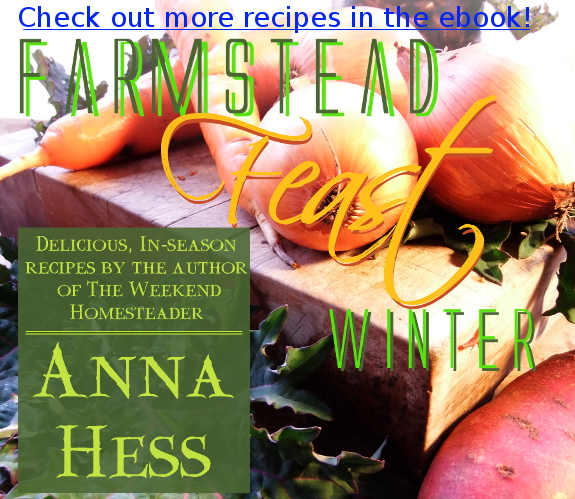

Oooo, I love homemade tomato sauce. I figured out pretty early that the trick to it was treating it like apple butter: cook it long and slow in a heavy-bottomed pan; you never want to hurry tomato sauce. I always thought that what I was doing was just cooking off the extra water, so I was very interested to find out that pectin comes into play too (I suppose that's the case for apple butter as well). Thank you for the information!
On a side note, I'm not quite sure why lasagna should be healthier than other types of pasta. Is it just the extra vegetables? Because I tend to throw extra vegetables into everything I make - especially at this time of year!
I live much farther north, so I am still impatiently waiting for my romas to turn red. When they do I will give your fresh tomato sauce a try. mmmmmm..... spaghetti sauce that does not have corn syrup in it...yum
Thanks
Roland and Ikwig --- I should have been clearer in my post and said my lasagna is better for you than my spaghetti. It's all about the ratio of vegetables and proteins to wheat --- I only use one cup of flour per eight servings of lasagna and end up with a meal that's over 30% protein. Granted, I could add the same overload of vegetables, cheese, and meat to spaghetti, but it just doesn't taste right to me. It sounds like Ikwig does what I do, but pours the good sauce on spaghetti, and probably gets the same results.
Justin --- I should have added a note about sweeteners. I find that with real tomatoes ripened at home, you don't need to add any, although sometimes when I'm ripening up the last fall tomatoes inside, they don't turn out as sweet and I add a bit of honey. Yet another reason to make your own!
think alike. Or great tomatoes ripen at the same time. I spent yesterday afternoon making seasoned tomato sauce for the freezer, and spaghetti for dinner. Yum!
I find the Amish Paste variety is even better than Romas for "meatiness." They also grow much larger fruits than Romas, as well.
I'll pretend to ignore the insult to my tomato sauce. Just a couple of comments: Anna's recipe won't work for a canned sauce unless you pressure can it--too many low acid veggies.
This year I am making a tomato puree using a Champion juicer with a solid blank instead of a juice screen. I clean and core tomatoes as needed, run them thru the juicer, heat puree in big pot until boiling, and can in quart jars in water bath canner for 30 min. I make the sauce when needed using canned tomatoes, spices, dried zuccini, grated carrots, onions, garlic, etc.
Aw, I didn't mean to hurt your feelings! It's not just your homemade sauce --- I've only eaten one homemade tomato sauce over the years that didn't end up exactly the same way.
You're totally right that you won't want to hot water bath can the sauce --- I freeze it. (Well, and eat it right away...) Sounds like you came up with a very good method for canned sauce!
Great article, I can't wait to try it. We have grown Romas this year and last year, and I was already eying the amish paste for next years seed order. I have tried making homemade sauce a couple of times now, and am excited at the prospect of a thicker bodied result. One tip I got from my father is to add a couple of pureed carrots for those that like a sweeter sauce but don't want to use brown sugar.
Also, we just recieved our 10 piece diy chicken waterer kit from you. Everything arrived as expected, and I am thrilled with the valves. Our flock of 4 week old hens took to them immediately, and they were super easy to install.
Thanks for all the great insight and info!
Joe --- We've been enjoying our thicker sauces for a year now, and I still highly recommend the method! We did try Amish Paste this year, but were very disappointed --- they get blight very quickly if you don't treat them with copper or some other heavy-duty anti-fungal (which we choose not to.) Our favorite roma remains Martino's.
Thanks again for trying out our waterer! I'm glad to hear your flock likes them as much as ours does.